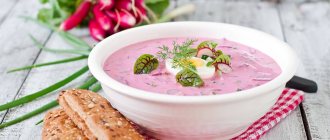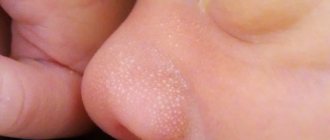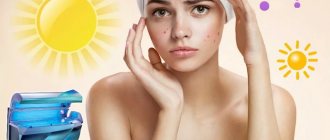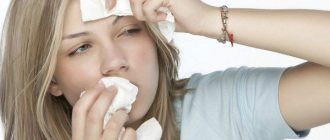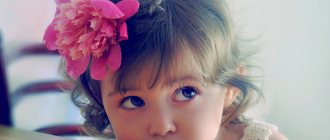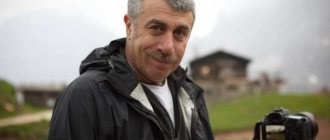How to teach a child to wash his face and brush his teeth every day?
The most important thing every child should do every day is wash his face and brush his teeth. Moreover, not only in the morning, but also in the evening. Before going to bed.
At an early age, you will have to wash your baby yourself. Make sure he brushes his teeth. And I washed my face. And when he grows up a little, he will begin to do it on his own.
At an early age, both procedures need to be done regularly. Every day. Morning and evening washing should become a habit for the child.
We recommend doing these procedures together with your child. When he washes his face and brushes his teeth, you should also do the same. The child should follow your example. Realize: “Mom washes her face regularly, which means I should do it every day too.”
If you wash your face with your child in the mornings and evenings for at least a month, it will become a habit for him. In the future, he will wash his face and brush his teeth without your prompting.
If your child resists washing regularly, have an explanatory conversation with him. Say that failure to comply with your demands is fraught with unpleasant consequences:
- If a child washes his face once a day or not at all, he will develop pimples and blackheads. Which look unaesthetic.
- If a child rarely brushes his teeth or does not brush his teeth at all, he will develop caries. Your teeth will turn black. And they will be spoiled for life. What will scare people away?
For clarity, find examples of children with facial acne on the Internet. And show their photos to your child. A similar example can be found with teeth that are damaged by caries. With 100% probability, the visualizations you provide will lead to the fact that the child will regularly wash his face and brush his teeth.
Provide your child with all necessary items for washing
Be sure to prepare all the necessary items for washing. Buy your child:
- A beautiful brush. If funds allow, then electronic. Your child will love brushing their teeth with it.
- Delicious toothpaste. Which will not only effectively clean the oral cavity, but also smell pleasant.
- Cleanser. If the child is still small, then the face can be washed with ordinary laundry soap. If you have a teenager, we recommend purchasing a specialized cleanser.
If you buy your child such items, he will enjoy washing himself. He will enjoy the process. This means you will wash your face regularly.
wipe a newborn's face
The body of a newborn usually reacts quite sharply to the environment, since its immunity is still only adapting to it. Based on this, it is extremely important to pay due attention to simple hygiene rules, which will reduce the number of negative factors that can cause a lot of trouble for the baby and his parents. But how to do it right? How to wash a newborn’s face, and how, for example, to clean ears or eyes? After all, the skin and mucous membranes of a baby are often able to react violently to any intervention.
It is extremely important that parents do not lose sight of this point and know the answers to the question of how to carry out daily child care, which should begin with such an important procedure as washing. It should not be produced with ordinary tap water, since the number of possible problems that can be encountered by resorting to this method is too great.
What you need for washing
A “standard” washing kit is quite simple and does not require the purchase of any fancy items. However, it is thanks to its components that you can easily cleanse the baby’s skin, face, eyes and ears, protecting them from various rashes, possible suppuration, and so on. So, what is necessary for daily hygiene and washing of a newborn.
Facial cleansing procedure for a baby
The sequence of steps for properly washing a newborn's face is quite simple. After unwrapping the baby, you can lay him on a changing table or other convenient surface. At this moment, it is extremely important to monitor the absence of possible drafts, since the baby’s damp skin is especially sensitive to them.
Having prepared the baby in this way, you should carefully, with light movements, wipe his face with cosmetic pads soaked in boiled water. It is highly undesirable to use it for such purposes.
Source
Navigation menu
Custom links
Announcement
User information
How to care for a newborn: what to wipe your face with and more
Posts 1 page 9 of 9
When a young mother comes home from the maternity hospital with her baby, it is very important that the child’s care is organized as correctly as possible. To do this, you must consider many different factors. So how to properly care for your baby in the first days of his life at home?
It is necessary to carry out wet cleaning at least twice a day, and you also need to ventilate the room regularly, 5 times a day for 15 minutes. The air temperature in the room should be no lower than 20 degrees and no higher than 22. There should be no bright light or too loud sounds in the room, otherwise the baby will sleep poorly and be frightened by extraneous noises in the future.
The baby's crib should be placed so that it is not exposed to direct sunlight, but do not place it in the shade. There is no need to put a pillow in the baby’s crib; instead, you should put a headrest 2 centimeters high, or immediately choose a crib with a raised part for the head. A changing table should be placed next to the crib so that it is convenient to swaddle the baby at any time.
All child’s clothing and underwear should be made only from natural materials and soft fabrics, such as cotton and linen. Clothes should not have rough seams. All baby items should be easy to wash. Before making the baby's bed or dressing him, things need to be thoroughly boiled, washed and ironed. During the first month, the baby's things should be ironed with a hot iron on both sides.
Clothing should under no circumstances restrict the baby’s movements; it should prevent hypothermia or overheating of the child’s body. If the room maintains a constant
Source
Many women have given up washing their face in the morning in favor of wiping their faces with ice cubes. They believe that such ice therapy will help them maintain youth longer - it will smooth out wrinkles and help fight imperfections - enlarged pores, excessive sebaceous glands, relieve irritation and remove rashes.
It is also believed that such a procedure strengthens blood vessels, improves blood circulation, which has a positive effect on the complexion and causes a natural glow. But is rubbing ice on your face actually beneficial?
How does ice work?
To understand whether this is useful or not and why you need to wipe your face with ice cubes, you should consider what happens when frozen water interacts with your face. At the same time, the skin quickly cools and the vessels located close to the surface rapidly narrow, while those that pass further expand. As a result, blood rushes to the surface of the epidermis and a blush appears.
In this case, contact with the cubes should be minimal so as not to chill the facial nerves and blood vessels. And after the ice is removed, the skin begins to breathe. You should not wipe your face dry after ice therapy.
It well stimulates the metabolic processes that occur in the cells of the epidermis. Because of this, they are renewed, minor wrinkles are smoothed out, sagging disappears, and skin aging slows down for a while.
For this, it is best to take ice cubes made not from tap water, but from still mineral water or distilled water. You can also make frozen juice or use tea or herbal infusion. At the same time, the active substances contained in grass, tea and fruits will increase the healing effect.
You can wipe not only your face, but also other areas of the body, for example, the neck and décolleté, but to avoid possible
Source
How to clean a newborn's ears? Why and is it necessary to do this at all? What safety rules should I follow? We'll tell you about all the intricacies of cleaning one of the most delicate areas on your baby's body.
Human ears have a complex internal structure that allows us to hear. To protect its three sections from external factors, wise nature provided the presence of a natural antiseptic - earwax. It is produced in small quantities daily and coats the outer part of the ear canals. When there is a lot of sulfur, it appears in the ear. And it is these excesses that need to be removed. If you actively extract the natural secretion from the “depths” of the ear, its quantity will actively increase and bring even more pollution.
5 rules for caring for a newborn's ears
Caring for your newborn's ears should become part of your daily routine. You don’t doubt that you need to wash your eyes or brush your teeth every day, do you? And you probably won’t calmly watch how a newborn’s navel bleeds? But in this delicate matter you need to know when to stop. Here are a few rules on how to clean a baby's ears that must be followed.
Care for the area behind your ears every day. Make sure that there are no traces of breast milk or formula left there, as they can cause diaper rash and inflammation.
Clean the inside of your ears once a week. Eliminating excess wax is necessary to maintain ear hygiene and reduce the risk of developing inflammatory processes.
Use special children's cleaning accessories. Cotton swabs for children are suitable for you. The shape of their heads is not as elongated as for conventional sticks, and has restrictions that prevent the object from passing deep into the ear.
Delete
Source
Since I read differently everywhere, it became interesting what someone uses more... I’m talking about the morning toilet of newborns... What do you wipe the folds with? and nose? I heard a lot about vegetable oil (at first about 20 minutes in a water bath), some with just water, some with creams... and I also heard that it is better to treat the navel not with brilliant green but with something else, they say the brilliant green gets dirty + underneath it the skin is a little warm, is that true? What do you use to treat your belly button? And what are Aquamaris drops for?
User comments
22
in the maternity hospital they recommended an alcohol solution of calendula... but only in the maternity hospital I used it to wipe the folds)))) at home an ordinary bath and Bübchen milk was enough, and I applied bepanthen to the redness
Folds with baby oil, although it seems only after bathing, in the morning with a wet cotton pad. I sprayed Humerer into my nose and cleaned it out with cotton swabs. Boiling oil is a thing of the past, IMHO.
but you can drip and moisten the turundas with saline solution - this is properly salted sterile water. and is much cheaper than aquamaris.
Aquamaris is water to rinse your nose. it liquefies everything there and the child swallows it. The nose doesn't get clogged. I used Aqualor, it’s more convenient!
folds bebchen no diaper rash all redness goes away no creams powder ointments are not nearby, the nose was first water then with vaseline oil at first boiled in a bathhouse and now I lubricate it like this, it’s not sterile but it’s not from the trash heap but from the pharmacy) and aquamaris is if it’s nozzles or so that the boogers go away, they get wet better and are easier to pull out, plus they have a healing effect due to the fact that they are salty
and about the navel, it’s better to treat it with potassium permanganate and peroxide, but now you can’t just buy potassium permanganate, so you can’t buy it with brilliant green (the doctor also told us that brilliant green can make you wet, “sours” to start
how to introduce an egg to a baby An egg is a storehouse of protein, which is so necessary for a baby for the development and formation of many organs and systems. That is why parents are interested in when they can give their child an egg.
Characteristics of a chicken egg
lonase.ru
How to teach a child to wash his hands?

In order for your child to wash their hands regularly, you need to make this action a habit. If your child is small, then tell him about the potential harm of unwashed hands. Explain that unwashed hands carry a lot of germs. Which can cause the child to develop illness. Explain to your child how to wash their hands correctly!
Add that if you do not wash your hands, your child may develop serious skin problems. Pimples and blackheads. They appear because children touch their faces with dirty hands.
When teaching your child to this procedure, you must be sure to set a good example. Wash your hands every time you return home.
Moreover, this must be done after each visit to the street. So that the child develops the habit of washing his hands when he comes home.
Buy your child all the hand washing supplies he needs.
For hand washing you can use:
- Liquid soap. It can be either tasteless or with a certain aroma.
- Regular scented soap.
- Nice towel. With it, the child will wipe his hands.
Chamomile and inhalations with it
Inhalations with chamomile are an effective remedy in the fight against colds. This use facilitates the rapid penetration of the miraculous drug vapors into the little person’s body. The baby is held in your arms and breathed through the pores over the prepared decoction for a maximum of 15 minutes.
The rational use of chamomile decoction, tea or baths will help many parents cure their baby of unpleasant colds, abdominal pain, skin inflammations not only quickly, but also safely for the baby. Chamomile flowers should be stored in a dry place, protected from light.
Preparation of liquid for indoor use: 1 teaspoon of dried chamomile flowers is poured into 250 ml of boiling water. Leave to leach for 15 minutes and then sneeze. Chamomile tea is drunk warmly, 3 times a day after meals. It is always fresh, just before use.
It adapts to a variety of climates, but works best in warmer, wind-sheltered locations. Sown either in autumn or spring, we sow in shallow furrows of about 1.5 cm, we choose lighter calcareous soil with a lot of humus in autumn sowing in winter with only a small rosette of leaves, sown from mid-August to mid-September, begins to bloom at the end of May, produces relatively high, when sown during the spring flowering period, the yield in the spring is sown a little less, sown in March-April, sown directly into moist soil, keep the soil constantly moist, sow the seeds do not cover the soil, sow either in rows about 15 cm apart, or in nests, chamomile daisy always gets rid of weeds.
The use of chamomile in different types and for different purposes is explained by its miraculous properties. It has bactericidal, anti-inflammatory, soothing and cleansing effects. As an absolutely natural remedy, it is used to improve the functioning of the gastrointestinal tract and strengthen the baby’s body after suffering from colds.
Collect flowers with stems no longer than 2 cm in dry weather, approximately 3-5 days after flowering. You can make a decoction, ointment, slab or various tinctures from chamomile. It is valued especially for its high blue silica content. It helps with stress, has healing effects, increases sweating, releases cramps, has an anti-inflammatory and disinfectant effect, helps against bloating, colic and stomach problems, is effective for coughs, colds and inflammation, stretches muscles, distributes chamomile oil, helps with menstrual pain or problems and relieves itching in skin rashes, hemorrhoids and burns, prevents the formation of scars, treats conjunctivitis or the so-called corn grains, it is good to wash out tears with teaspoons of tea.
Chamomile products are classified as herbal medicine, so you should consult your pediatrician before use.
How to teach your child to take a shower or bath regularly?

To keep your child's body clean, he should take a shower or bath regularly.
Getting your child used to washing their body is not difficult. It is enough to explain that if you do not wash, an unpleasant odor will emanate from the child. Which will disgust others.
If you have a bathroom at home, then the process of washing your body can be turned into an interesting and fun procedure. At a minimum, the child can simply splash in the water. At the very least, he can take a bubble bath. And enjoy it.
It is important that while bathing in the bathtub the child does not forget why he got into it. And he carefully washed all parts of his body. Armpits, legs, groin area and so on.
When your child is in high school, teach him to take a shower. Justify the usefulness of such a procedure by the fact that it takes less time than bathing. Because it takes at least half an hour to wash in the latter. And you can take a full shower in just five to ten minutes.
Teenagers appreciate it when they have the opportunity to save time.
What products do you need to buy to make it comfortable for your child to wash?
To make it comfortable for your child to wash in the bathroom, we recommend purchasing the following items:
- Shampoo. For babies, we recommend purchasing baby shampoo. It contains special elements that, if they come into contact with the eyes, do not sting. For adult children, you can buy regular shampoos. With or without scents.
- Shower gel. We recommend buying children's shower gels for babies. They are very convenient to use. And they are presented in different forms.
- Soap. Can be used as an alternative to shower gel. You can buy any soap. Both ordinary and economic.
- Towel. For bathing or showering, we recommend purchasing larger products. So that the child can completely wrap himself in a towel after washing. And he didn’t catch a cold when he went into the other room.
Acne on the face of a baby
In the first days of life, a child is most susceptible to various diseases.
This is due to the work of the immune system, which is just being formed and cannot yet fully protect the child’s body. To maintain the baby’s health, parents resort to traditional methods, namely:
- regularly ventilate the children's room;
- take walks with a newborn;
- wrap the child well even in sunny weather;
- feed only breast milk or high-quality nutritional formula;
- provide healthy sleep;
- visit the supervising doctor and follow all his recommendations.
But even with such vigilance, the child can get sick. In most cases, the body acquires immunity to various kinds of diseases and is no longer subject to their repeated manifestations in the future. Pimples on the face of a newborn can occur for several reasons, and in order to eliminate the unpleasant rash in a timely manner, you need to know its nature.
Causes of acne in newborns
Most often, the appearance of a rash on a child's face is the result of hormonal changes and is not treated. But it happens that pimples on a baby’s face are caused by a malfunction in the body. In any situation, you should immediately contact your treating pediatric specialist, who will give an accurate definition of the rash and determine further actions. You cannot carry out treatment on your own! Why does a baby have pimples on his face? The main causes of pimples in babies include the following:
- The body's reaction to certain nutritional components. Here we are talking about mother's nutrition. Favorite foods can become allergens for your baby. Also, the reaction often occurs due to unsuitable infant formula or its sudden change.
- When moving or traveling, pimples on the face of newborns are normal. This is how a child’s body reacts to climate change.
- Miliaria is a rash and redness on the baby’s body and face caused by hot weather. The heat rash goes away quickly if you properly care for your child’s skin.
- The opposite of prickly heat is the phenomenon of pimples in babies due to cold weather and wind. During this period, the skin is very sensitive and easily prone to rashes.
- Just like adults, children's skin can react to body care products. Special creams, powders, and oils, although they contain safe ingredients, can cause undesirable consequences. That is why you should not buy such products without the advice of a doctor, no matter how convincing the advertising campaigns may be. The skin of babies should be protected as much as possible, including from “care products”.
- If your baby is bothered by rare or frequent bowel movements or colic, this is a sure sign of dysbacteriosis. Parallel to these signs, irritation on the face begins.
The appearance of white pimples
White pimples on a baby's face are even more worrisome than red rashes. As in adults, this disease is the result of hormonal changes, but there is no reason to panic. White inflammation is painless and does not cause discomfort. Reasons for their appearance:
- the period of adaptation of the body to the new environment;
- excess hormones.
If a mother often eats sweets or exotic fruits, white pimples may appear on the baby’s body. As soon as a rash has formed, you need to inform the supervising doctor and follow his recommendations. This is the first thing to do.
Many parents resort to the advice of other mothers and fathers, traditional medicine, thereby risking worsening the child’s condition. It is advisable to consult with a specialist about certain treatment methods and not try to do anything without his recommendations.
Pimples on the cheeks appear in babies for other reasons:
- allergy to infant formula;
- lack of oxygen to skin tissues, for example, due to the child’s constant stay in a diaper.
Since a newborn's legs are bent, the skin at the bend site often sweats. It is necessary to regularly treat these areas and other folds with baby cream. Frequent water treatments are also required to ensure body hygiene.
The appearance of red pimples
This type of skin rash most often occurs in newborns. Red spots appear on the body and face and do not cause pain, but they need to be treated immediately. As already noted, you first need to see a doctor, and only then carry out treatment and prevention.
There is no need to worry too much about red pimples, as this is a normal phenomenon and does not harm the body. You need to get rid of the rash only after the cause has been established. Many parents are afraid of the risk of rosacea in their infants, because the symptoms are almost the same.
In fact, this disease extremely rarely affects the child’s body, not to mention newborns. Rosacea mainly affects young and mature people.
Red rashes indicate the following problems:
- Diathesis is one of the most common childhood diseases. During diathesis, the baby is often capricious and cries. The red rash disturbs the child with increasing itching, which is why the newborn sleeps little, and in this period sleep is the most important thing for the child’s health.
- Hormonal changes in a child's body occur with the same consequences as in a teenager. Pimples appear on the forehead, nose, cheeks and chin, then spread to the body. They are painless and do not bother the baby.
Treatment
Typically, acne on the face of a baby is short-lived and goes away without special treatment. Since the baby's skin is very delicate in the first days of life, it is easily susceptible to infections.
Doctors do not recommend treating a child on their own, relying on advice from home or women’s forums. It is better to play it safe and consult with your supervising doctor. General rules for caring for your baby’s skin, including acne, include:
- At each bath, it is necessary to ensure that no detergent remains on the child’s body. Even minor soap residues can cause an allergic reaction. It is important to select products that are created exclusively for newborns.
- Pimples on a baby's face can be cured with a decoction of chamomile or string. Herbal baths will calm inflammation and dry out existing acne.
- Wash regularly with boiled warm water (about 3 times a day, more often in the summer).
- The room should be constantly ventilated, especially before going to bed.
- Acne on the face of a newborn must be treated very carefully and only with the composition recommended by the attending physician.
- Alcohol solutions are prohibited for infants.
- It is not recommended to use fatty ointments and creams, antihistamines and antibiotics.
Prevention of rashes in children
Pimples may appear on a baby's cheeks due to poor hygiene. To ensure maximum skin care for your baby, you must regularly follow the general recommendations:
- Ventilation of the children's room should be carried out at least 4 times a day. It is advisable to have a home thermometer to check the room temperature; the optimal temperature is 21 degrees.
- Lighting should be average.
- In the crib, at the head of the bed, you need to put a lining 1.5-2 cm high instead of a pillow.
- For convenience, the changing table should be placed next to the crib.
- All materials that the baby comes into contact with must be made of hypoallergenic compounds: linen, cotton. Often it is uncomfortable clothes that cause pimples on the body.
- During the first month, a newborn's bedding must be carefully ironed on both sides, as any folds will cause irritation.
- Children's clothing should be washed separately from other clothes.
Baby facial care
How to wipe a newborn's face for acne? It is important to use only products recommended by your doctor that do not contain alcohol. The washing process requires certain skills. The morning routine should begin before the first feeding.
[youtube width=”720" height=”315"]kJW9CeeN3p0[/yo[/youtube]
A warm stream of boiled water is perfect for the delicate skin of a baby. The eyes are wiped separately with a cotton swab moistened with the same water. Movements - from the outer corner to the inner, without pressing on the eye socket. A separate swab is provided for each eye.
Pimples on the chin are treated very carefully so as not to damage the thin skin, otherwise complications may arise. A light decoction of the string will soothe and dry out acne. You can use potassium permanganate, but in small quantities. The solution should turn out pinkish.
MaskaLico.ru
How to teach your child hygiene after using the toilet?

When going to the toilet, the child must also adhere to the following hygiene rules:
- Girls, after they come down, should wipe their groin.
- Boys, after they come down in a small way, must “shake off” their genitals. To avoid staining your panties with liquid residue.
- After the child has gone big, he should wipe his bottom with toilet paper. And, if possible, go straight to the bathroom. To wash myself.
Make sure your child follows these procedures when using the toilet. If he doesn't do this, he will be dirty. This can lead to an unpleasant odor. And the appearance of skin irritations.
If you have a small child, then at first he will be afraid to wipe his butt on his own. Don't force him to do this.
He must learn to wipe his own butt.
Buy comfortable toilet paper for your child
Don't waste money on toilet paper. If it is soft and of high quality, then the child will feel comfortable wiping his butt with it.
If the toilet paper is hard, the child will experience discomfort. And he will be afraid to use it himself.
How to properly prepare chamomile infusion
Chamomile infusion is brewed in two types, depending on the form of release.
- Filter bags. 2 filter bags are placed in a glass or enamel container, pour 100 ml of boiling water, cover with a lid and leave for 15-20 minutes. After this, the filter bag is squeezed out, and the finished infusion is brought to 200 ml with boiled water.
- Chamomile in bulk. 1-2 tablespoons are poured into a glass or enamel bowl, pour 100 ml of boiling water, then placed in another enamel bowl and infused in a water bath, bringing to a boil over low heat for 15 minutes. When the broth is ready, it needs to be filtered and diluted to a volume of 200 ml with boiled water.
Each age has its own dosage of the decoction. Infants can drink 1-2 teaspoons of chamomile infusion, but not more than 2-3 times a day. Keep the finished broth in a cool place for no more than a day.
Maximum essential oil yield occurs during full development. It has a very pleasant spicy smell and somewhat bitter taste. The best quality of dried chamomile is characterized by the fact that they contain only heads free of stems and leaves, without broken tubular and reed flowers and flower beds without baldness. The sages should also not be present, and the flowers should have the shortest stopwatch. Dried chamomile flowers have a characteristic aromatic aroma and slightly bitter taste. Store them in a dry place, protected from light and moisture.
Tea: used in flatulence, intestinal colic and disorders, gastric disorders and colic, colds, bronchial catarrh, cough, insomnia, epididymitis, shortness of breath, dysmenorrhea, uterine cramps, disorders or amenorrhea. Blood vessels, gastrointestinal infections, diarrhea, urinary tract infections.
How to teach your child to brush his hair regularly?

The next thing you need to teach your child is to comb his hair. Give him a comb. And tell him that you need to use it every time before going outside.
Explain to your child how to use the comb:
- If he wears his hair up, then his head needs to be combed accordingly. You need to start combing your hair on the left. Gradually moving to the right side of the hairstyle. So that every part of the hair is combed.
- If a child wears his hair down, then it needs to be combed accordingly. So that no part of the hair sticks out.
How to treat a newborn’s folds – How and what to treat a newborn’s folds
The sensitive, easily vulnerable skin of a newborn requires especially careful, systematic care.
Regurgitation during the day, milk flowing behind the neck, natural discharge, friction, stuck villi - provoke inflammation and diaper rash in the area of skin folds, sometimes very painful.
They often cause anxiety and crying of the baby. To avoid this, it is important for the mother to learn how to care for the skin and treat the baby’s folds.
Caring for newborn folds. What and how to do?
Good day, dear reader! Today we will talk about what care for a newborn’s folds is considered correct, what products are best suited for a baby. This knowledge will help you avoid daily mistakes and prevent painful diaper rash and irritation in your child.
